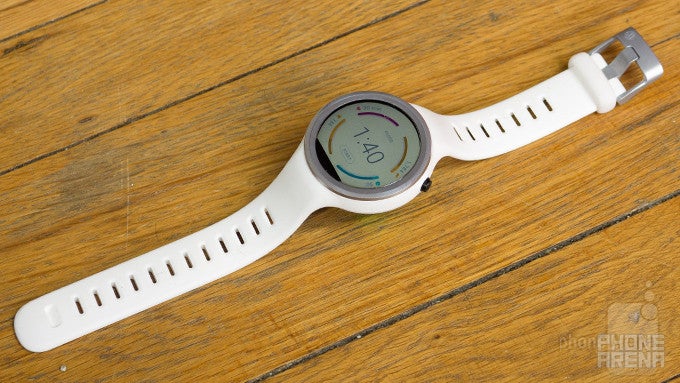Moto 360 Sport Review

Introduction
Being teased off during IFA 2015 back in September, the Moto 360 Sport caught our attention because of its stark difference from most other smartwatches in the Android Wear sphere. While most other offerings try to approach the premium side of thing, it’s somewhat of a refreshing change of scenery to find something totally different. Although it might be quickly panned as a sportier variant of Motorola’s popular smartwatch and nothing else, there are actually several additions that make it unique, not only in comparison to the current Moto 360, but to the entire Android Wear portfolio as it is.
The package contains:
- Moto 360 Sport
- Wireless charging dock
- Wall charger
- Get started guide
- Safety information
Design
Yes, it’s sporty in design, but there’s no substantial increase to its water resistant properties.
Obviously, the ‘sport’ in its name aptly describes the smartwatch’s overall design style, which shouldn’t be too surprising to know that it specifically adheres to the active individual in mind. With its adjustable silicone strap, a rubbery feeling material that’s sweat resistant, the Moto 360 Sport is the kind of watch that’s perfect for workouts. You can rain down sweat with no fear of the strap fading, or internals going bad.
That’s because the sporty style, in combination with its IP67 certification, ensures that it’ll endure the most intensive activities and workouts. It can technically survive submersion to an extent, but the company refrains users from swimming or continually exposing it to water for long periods of time. For something that’s selling itself to those with an active lifestyle, we were really hoping to see greater protection at this point – you know, a bit more than the usual.
Unlike the rich personalization presented to us by the standard Moto 360, the Sport is only available in three colors – white, black, and flame orange. Therefore, there’s no mixing or matching different bands with this one. Interestingly, it seems at first that it’s possible because of the way the casing seems to be held in place by the strap, but that’s not the case at all.
Much like its sibling, the Moto 360 Sport features a built-in microphone, a physical button in the 2 o’clock position, and a heart rate sensor on its underside to measure our pulse. It should be noted, though, that it’s different from the majority of smartwatches on the market because it packs its own built-in GPS – enabling precise tracking for our runs outdoors.
Of course, its specific styling isolates its appeal to a specific group of people. Fitness junkies will undoubtedly eat up the sporty design, but it’s something that becomes out of place for casual events. Come on, it’s out of character for an important business meeting – or that date who you want to impress later on at a fancy restaurant. And the more we think deeper about the design, the more we realize that it’s quite frankly limiting, seeing that the standard Moto 360 can go from a sophisticated look with a metal band, to something sporty too if you happen to pick up third party rubbery textured bands.
Display
Superior visibility outdoors thanks to its ‘AnyLight’ display, but the poor viewing angles severely dull down the colors.
Besides GPS, the other thing that makes this smartwatch unique is that it features what Motorola is dubbing the ‘AnyLight’ hybrid display, ensuring that visibility isn’t compromised indoors or out. The display turns out to be a 1.37-inch 360 x 325 LCD panel with a reasonable pixel count of 263 ppi, which is effective in reading out fine text on the screen. Now, the AnyLight technology behind the display keeps it visible even in direct sunlight due to the strong contrast of the screen – whereas others are challenged because of heavier reflection.
Naturally, low light doesn’t pose any issues with visibility, but there is just a single downside to this new piece of tech. Looking it straight on is never a problem, but the poor viewing angles of the display causes everything to appear drab. That includes colors, which sadly exude duller tones that lack intensity to capture our attention. In comparison to the display used by the current Moto 360, this AnyLight one just seems too subdued for our liking.
We do, however, appreciate how it’s protected by a layer of Gorilla Glass 3. And it even helps that there’s just a subtle recess, so that we’re not too concerned about it getting scratched if it’s placed on a surface of some kind. Love it, or hate it, the same ‘flat tire’ look is present here once again.
Interface and Functionality
For something sporty, it really doesn’t have a lot to offer that we don’t get in any other smartwatch already.
Aesthetically, it has many qualities that fittingly adhere to its sporty nature. On the software side, though, we’re rather disappointed that it doesn’t elevate from what we’re used to on other Android Wear smartwatches. By that, we mean that there are only a couple of things different that separate the experience here from any other Android Wear device on the market. And for something geared towards fitness buffs, it’s nowhere close to matching the experiences we get in standalone fitness trackers like the Microsoft Band 2 or Fitbit Surge.
The first thing noticeably different here is the ‘Sport’ watch face, which true to its name, provides us with some meaningful information about our fitness attributes right from the beginning – like our step count, calories burned, heart rate activity, and much more. Secondly, the only other thing tacked onto the experience is the companion running app to Moto Body; the predictably named Moto Body Running app. This works in conjunction with the built-in GPS, enabling it to precisely track our runs outdoors, but it only offers the generic stuff you’d expect from any other running app that’s available out there. Calorie tracking is available courtesy of the app, during activities and at rest too. The data obtained by ot can also sync with other popular fitness apps.
Still, we're expecting more out of this to justify itself from being passed over for some other Android Wear smartwatch.
Processor and Memory
Zippy and fluid, there’s barely a hitch with its performance.
Fashioned with the same internals as its sibling, the Moto 360 Sport comes with a quad-core 1.2GHz Qualcomm Snapdragon 400 chip with the Adreno 305 GPU and 512MB of RAM, to ensure that things move relatively smoothly. And it does!
Donning 4GB of internal storage, it’s a decent tally that not only allows us to store some apps natively, but we can even use it to store music as well.
Connectivity
Using an LG V10, the Moto 360 Sport’s Bluetooth 4.0 LE connection manages to keep a firm connection up to 25 feet before it’s severed. However, now that Android Wear supports Wi-Fi connectivity, we can still continue to enjoy receiving notifications and other things with the smartwatch even when it’s not connected to a smartphone.
Battery
Average, average, average.
Armed with a 300 mAh battery, its performance isn’t greatly different from what we’ve been seeing lately in the space. To be more exact, a full tank easily gets us close to 1.5 days of normal usage – where it’s usually between the 40% to 50% range by the end of the first night. We do continue to enjoy using the included wireless charging cradle, seeing that it’s still quite a rare feature to find in many smartwatches.
Conclusion
Looking at what’s been released ever since Android Wear’s inception, we can certainly agree that everyone has been striving for that perfect design – you know, the premium kind that sparks interest right from the get-go. The Moto 360 Sport, on the other hand, is undeniably different from the majority due to its sportier styling, but underwhelming in several ways.

Throw in the fact that its cost, too, is exactly the same starting price as the current 2nd generation Moto 360 at $299.99, we find it to be an unconvincing package that won’t deter most people from looking at what else is out there. Unless you indeed prefer a sportier design in a smartwatch, there isn’t a whole lot here that paints a compelling story.
Software version of the review unit:
Android Wear Version: 1.3.0.2423127












Things that are NOT allowed: